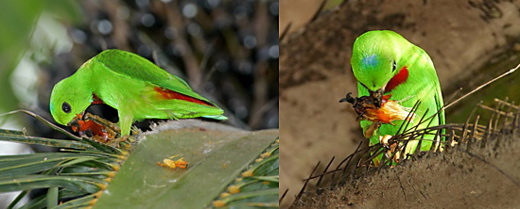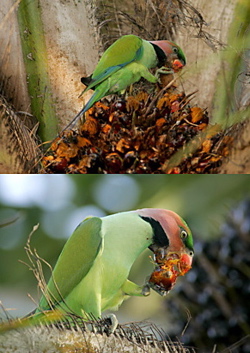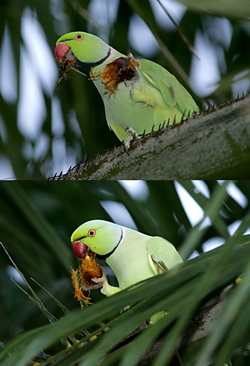It was raining almost every evening, depriving Eileen and myself our usual walk in the Singapore Botanic Gardens (SBG). Then one evening sometime last week, the sky cleared. We had our walk but along the way we were distracted by the arrival of a flock of noisy parakeets. They came for the ripening oil palm (Elaeis guineensis) fruits.
The Long-tailed Parakeets (Psittacula longicauda) that arrived noisly landed on the palms. Greedily, they feasted on the ripe fruits. Being messy and wasteful eaters, they littered the ground below with half eaten fruits.
The birds would first wrench a ripe fruit from a bunch with the help of their powerful beak. Standing on one foot, the fruit would then be passed on to the other foot. Grasping the fruit in this foot, the flesh of the oil-rich fibrous outer layer would then be torn off by the powerful beak and eaten (left).
It was rather amusing to watch the antics of these parakeets, as they moved sideways along the frond stems, snatching the fruits and eating them. At times they flew from frond to frond, looking for different bunches with the choicest ripe fruits. The Long-tailed Parakeets were easy to recognise, with their colourful plumage and prominently long tail-streamer. But they were always noisy.
A pair of Rose-ringed Parakeets (Psittacula krameri) arrived later but invariably they flew off whenever the Long-tailed appeared to feed on the same bunch of fruits. These were just as attractive, easily recognised by their distinctive black and pink collar (right).
Just then we noticed a smaller, mainly green bird, moving over another fruiting bunch, hanging upside down to get at the choicest, otherwise inaccessible, ripe fruit (top). Like the parakeets, this cute little Blue-crowned Hanging Parrot (Loriculus galgulus) ended up perching on one foot to transfer the fruit from beak to the other foot before eating the oily outer layer. It was a joy to be able to spot this rare parrot.
Input by YC who wishes to thank Chan Yoke Meng for taking the above images.












One Response